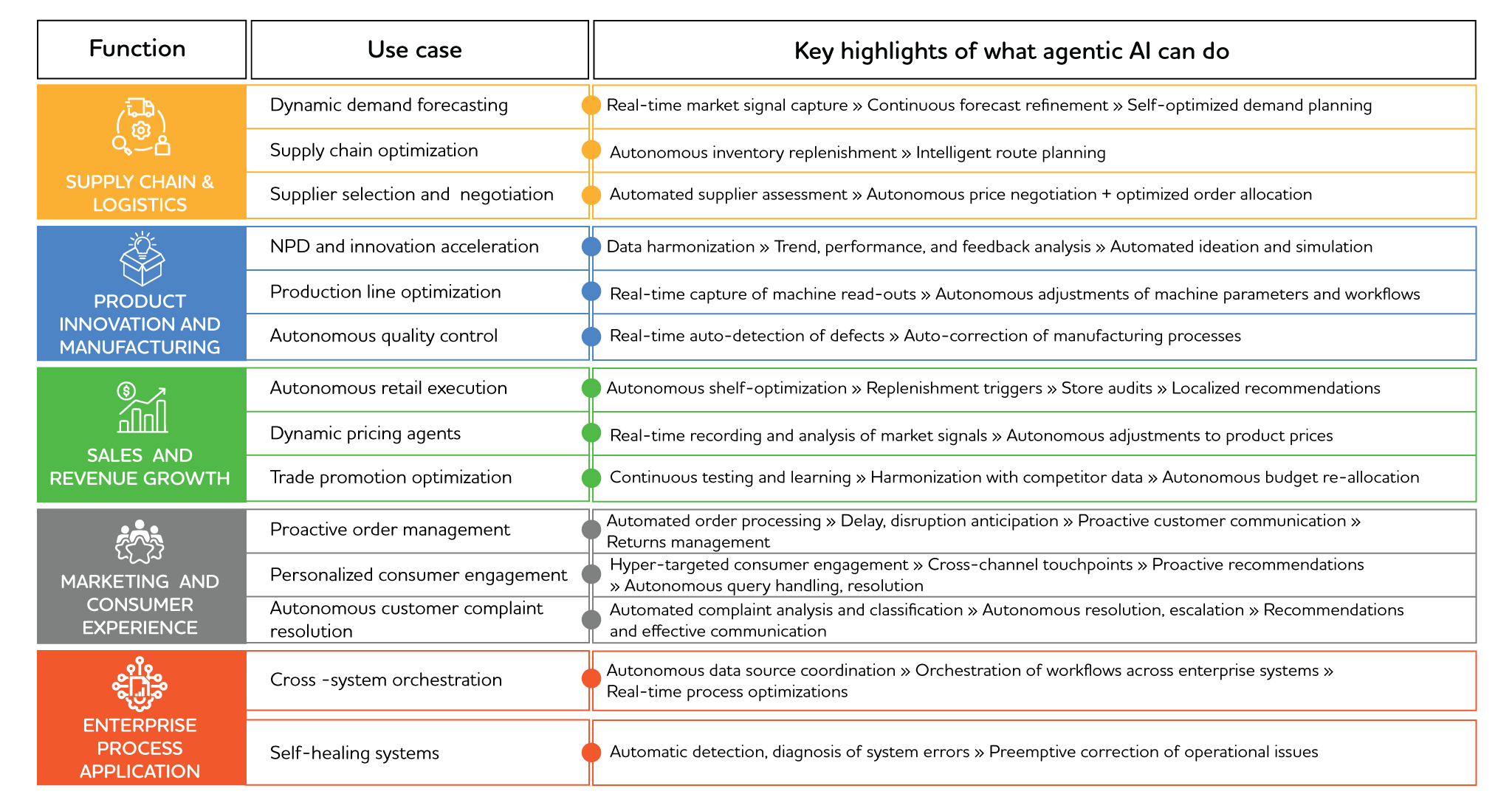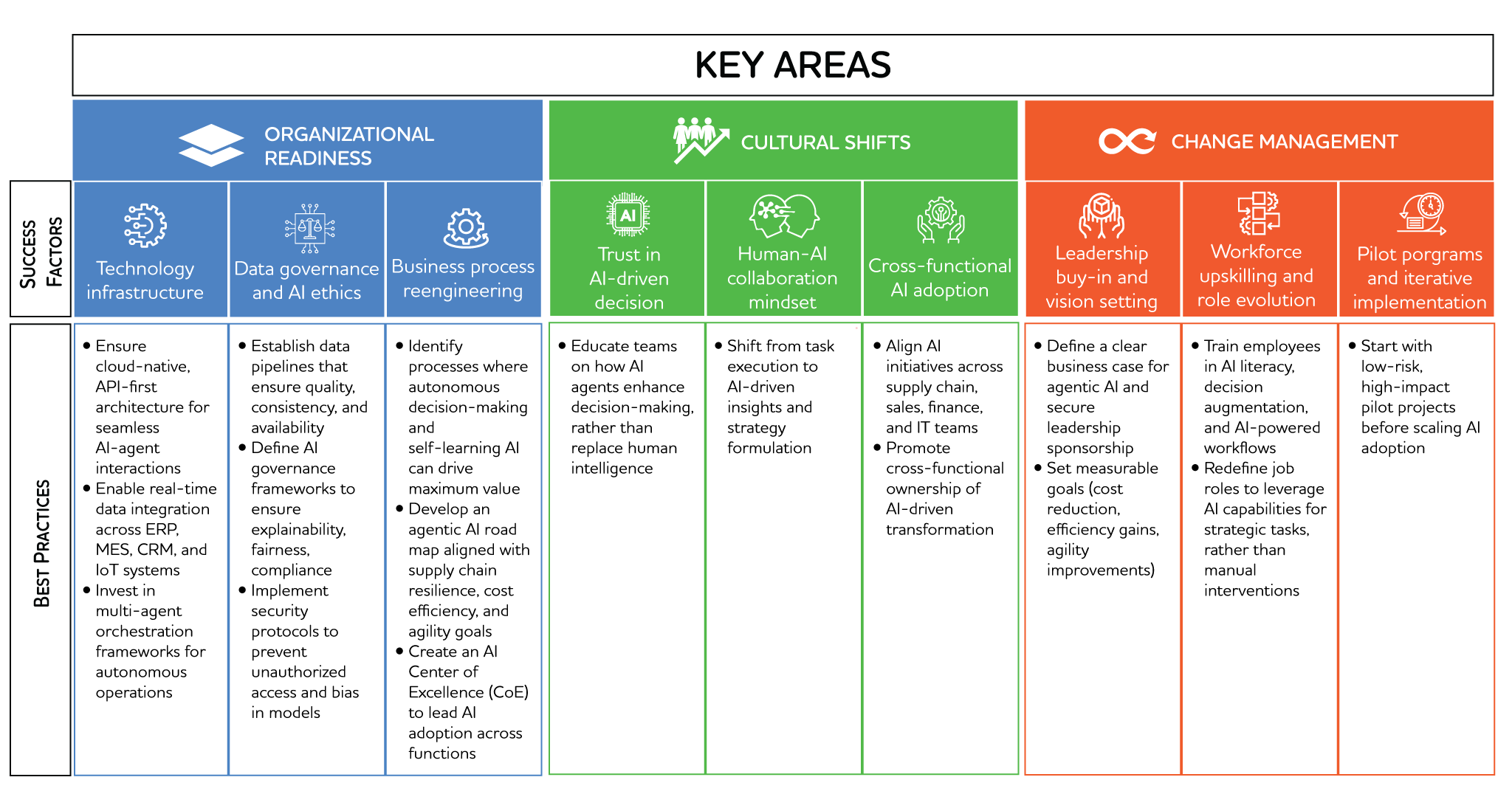Highlights
- Agentic AI can empower CPG businesses to move from reactive strategies to anticipatory, data-driven operations with minimum or no human interventions for greater agility, improved efficiency, and enhanced customer experience.
- The rise of agentic AI is heralding a transformative era for the Consumer-Packaged Goods (CPG) industry, offering unprecedented levels of autonomy, intelligence, and adaptability.
- A successful transition to an agentic AI-led autonomous future needs to be driven by a holistic strategy that addresses, in addition to technological considerations, the cultural shift in ways of working and effective change management.
Making a case for agentic AI in CPG
With shifting consumer expectations, complex supply chains, and volatile market dynamics, consumer packaged goods (CPG) companies face an unprecedented convergence of challenges.
Without the ability to make agile, data-driven decisions and execute them at scale and with speed, businesses risk losing ground to more adaptive competitors.
Artificial intelligence (AI) and automation technologies existing prior to the rise of agentic AI have made significant contributions to the industry, but each of them has had inherent limitations, precluding them from fully addressing the industry’s challenges (see Figure 1).
Broadly speaking, there are eight challenge areas that prevent current AI and automation technologies from holistically augmenting CPG operations. They are:
Traditional AI and automation tools are designed to optimize discrete processes and automate manual tasks. They are not built for orchestrating complex, multi-functional operations, or providing real-time, cross-functional coordination between functions (eg, procurement, manufacturing, logistics).
AI and automation often struggle with scaling processes beyond structured, predictable workflows. When applied to different geographies, they require retraining and fine-tuning, making it difficult to redeploy solutions in new markets.
Most AI-driven analytics tools provide retrospective insights rather than real-time, actionable intelligence. Many CPG companies rely on dashboards and reports, requiring human intervention to interpret and act upon them. This results in slow reactions to market fluctuations.
While improving efficiency within isolated functions (eg, optimizing delivery routes, forecasting demand), these systems fail to consider holistic cost trade-offs in the value chain. This often leads to inefficient budget and resource allocation across functions.
AI models often rely on historical data and predefined parameters, making them ineffective in responding to sudden shifts in consumer preferences, competitor actions, or macroeconomic events. This rigidity means that companies struggle to pivot quickly when unexpected disruptions occur (a viral social media trend or a sudden tariff hike).
Analyzing vast amounts of data from diverse sources (sales, supply chain, market trends, social media) simultaneously to make holistic decisions that optimize for multiple goals (eg, minimizing stockouts while reducing waste and logistics costs) are not easily achievable with traditional AI and automation frameworks. Information is often siloed across different departments (research and development (R&D), marketing, sales, supply chain), hindering collaboration and preventing a true end-to-end view of operations. This lack of visibility impacts inventory management, demand forecasting, and responsiveness to operational bottlenecks.
Delivering hyper-personalized recommendations requires systems that not only understand customer preferences but also orchestrate actions needed across marketing platforms, inventory systems, and even product development.
Bringing new products to market quickly in response to trends is crucial but often slowed by siloed knowledge, manual R&D processes, and lengthy testing cycles.
Agentic AI is the next iteration in AI’s evolution that aims to plug these precise gaps (see Table 1).
Agentic AI will take businesses beyond static automation and predictive analytics to systems that can autonomously plan, reason, and act in complex environments. Unlike existing technologies, it continuously learns, adapts, and collaborates with other systems in real time to drive outcomes with minimal intervention. It doesn’t just surface insights–it drives execution, responding dynamically to disruptions and operational constraints, and actively optimizes operations, reducing inefficiencies and unlocking new growth opportunities.
Agentic AI-infused CPG ecosystems
Agentic AI heralds an inflection point in the way organizations interact with technology.
It helps them move beyond reactive responses, passive analysis, and execution to systems that can proactively pursue specific objectives with minimal human intervention.
A steady stream of breakthroughs in the agentic AI space, coupled with the generalizable nature of the underlying language models, has a critical implication for how CPG organizations should approach enterprise AI implementations. It is now as much a question of adding new features and capabilities as of reimagining work systems as a whole. It is not about just replacing existing tech stacks, but centralizing AI and other digital efforts into a system that can re-engineer business processes by placing AI agents at critical nodes within workflows, elevating them towards autonomous operations and orchestration.
The operational framework of agentic AI often follows a four-step, problem-solving approach: perceive, reason, act, and learn. Consequently, in the context of the CPG industry, agentic AI can drive autonomous enterprise operations by enabling six broad capabilities.
A well-orchestrated multi-agent framework can go beyond automating isolated tasks or creating stand-alone reports–it can make decisions, initiate actions, and execute them to achieve business (eg, optimizing inventory levels based on real-time demand, weather, and logistical data, then automatically adjusting orders).
Agentic AI systems can also solve complex, multi-variable challenges, which had been under the sole purview of human agents so far (eg, inventory balancing, demand variability management, supplier disruptions), by harmonizing multi-source data intelligence and analyzing and reasoning through them by coordinating multiple agents.
This ability to solve complex problems can allow CPG organizations to deploy machine-first systems capable of automated, real-time, data-driven decision-making across functions like supply chain, marketing, and operations. This can enable better market exposure and improved consumer experiences for CPG.
CPG businesses will no longer be caught off-guard with sudden shifts in market or operational dynamics as agentic AI systems can monitor internal, external signals and make real-time adjustments to production, distribution, and pricing strategies, ensuring a resilient supply chain, adaptive marketing functions, and enhanced consumer experiences.
Beyond quick responses, agentic AI systems can preemptively predict and resolve disruptions by reorganizing processes in a relevant and timely manner.
Agentic AI systems are designed to continuously learn and refine outputs based on outcomes, feedback data, and updated information stacks (a ‘data flywheel’)–driving increasingly efficient and effective business processes through smarter recommendations, better inventory management, and more responsive pricing strategies.
Use cases for agentic AI applications in CPG industry
Organizations can look at agentic AI not as the sum total of individual use cases but as a framework to build an autonomous enterprise in the near future–completely transforming the way technology interacts with businesses and the people within.
Figure 2 showcases a few user stories from a hypothetical frozen foods manufacturing company with a global footprint to help highlight how agentic AI can reshape ways of working within CPG organizations.
Building along similar lines, Table 2 below gives a glimpse into the myriad ways agentic AI applications can transform business functions within CPG companies–underlining why business leaders need to focus on it today and not wait for tomorrow.
Preparing for an autonomous CPG future
The journey towards integrating agentic AI into the CPG ecosystem requires more than technological advancements.
It demands a holistic transformation in how organizations think, operate, and adapt.
Achieving success in this transition hinges on addressing three critical areas: (a) achieving organizational readiness, (b) fostering cultural shifts, and (c) implementing robust change management strategies (See Figure 3).
While business leaders will be familiar with most, if not all of these elements, we can share our insights based on our experiences in what is driving success in enterprise implementations of emerging AI technologies (see Table 3).
As agentic AI becomes more embedded in CPG operations, it will transform both business processes and consumer interactions. Beyond optimizing workflows, AI agents will refine core decision-making mechanisms, accelerating smarter choices at every decision-node along the value chain. The potential for such reimagined work systems spans the entire CPG ecosystem. This will eventually lead us to the holy grail for CPG organizations–an autonomous enterprise run by a central digital brain that knows the intricacies of business, understands process workflows, reasons its way towards nuanced decisions, orchestrates digital systems to execute complex actions, and evolves through self-reflection and learning. The opportunities are endless, which makes it all the more critical to lay the right foundation quickly. The companies that adopt the agentic AI paradigm early–guided by a strategic clarity and cohesive implementation–will secure competitive advantage in an increasingly saturating market, positioning themselves as pioneers for the future.



